Research on Multi-Scenario Variable Parameter Energy Management Strategy of Rural Community Microgrid
Abstract
:1. Introduction
2. System Structure
3. Real-Time Control Strategy Considering Cost per kWh of Storage Batteries
3.1. Mathematical Model of Control Strategy
- When the SOC status of the ESS is lower than the set value SOCpro, the grid electricity price is lower than the cost per kWh of the ESS, charge the ESS first if possible.
- When the photovoltaic power is greater than the load power, charge the ESS. When the grid price is low, purchase electricity from the distribution grid to ensure the charging power of the ESS.
- When the utility price is low, use as little energy from the batteries as possible, and try to supplement the ESS when SOC is lower than the preset SOCpro.
3.2. Simulation Results and Analysis
3.2.1. Data and Parameters
3.2.2. Simulation Results and Analysis
3.2.3. Analysis of Economic Benefits
4. Optimization of Multi-Scenario Parameters Based on PSO
4.1. Parameter Optimization Method Based on PSO
4.2. Multi-Scenario Variable Parameter Optimization
4.3. One-Year Running Effect Comparison
5. Introduction and Analysis of Experimental Results of the Demonstration System
5.1. Introduction of the Demonstration System
5.2. Analysis of Running Effect and Experimental Waveform
6. Conclusions
Author Contributions
Funding
Conflicts of Interest
Nomenclature
| Symbol | Description |
| Ppv(t) | Photovoltaic power at time t |
| PL(t) | Load power at time t |
| The power margin | |
| Pes(t) | Power of energy storage system |
| Ppcc(t) | Power of PCC point |
| Ces_unit | Cost per kWh of the ESS |
| Crep | Total cost of replacing the batteries |
| Elifecycle | Total energy of the ESS |
| Cg_unit | Utility electricity price |
| V(t) | The utility electricity price at time t |
| Charge and discharge efficiency of the ESS | |
| The maximum chargeable power of the ESS | |
| Maximum dischargeable power of the ESS | |
| Maximum absorbable power of the PCC | |
| Maximum power the PCC point can provide | |
| The abandoned power of PV | |
| SOC(t) | The SOC of ESS at time t |
| SOCmax | Maximum SOC limit |
| SOCmin | Minimum SOC limit |
| Pcut(t) | The cut power of unimportant load |
| COSTt | Total electricity cost |
| Mg | Electricity fee for the utility |
| Mps | Policy subsidy income for distributed generation |
| CBS | The loss cost of the ESS |
| ICBS | Total cost of the ESS |
| DAM | Loss coefficient of the ESS |
| Ac | Equivalent throughput in the time period to be calculated |
| Atotal | Equivalent throughput of the entire life cycle |
| Equivalent throughput conversion factor | |
| Comprehensive cost |
References
- Hatziargyriou, N. Microgrids: Architecture and Control; Wiley-IEEE Press: Piscataway, NJ, USA, 2013. [Google Scholar]
- Mohn, T. It Takes a Village: Rural Electrification in East Africa. IEEE Power Energy Mag. 2013, 11, 46–51. [Google Scholar] [CrossRef]
- Maheshwari, Z.; Ramakumar, R. Smart Integrated Renewable Energy Systems (SIRES) for rural communities. In Proceedings of the 2016 IEEE Power and Energy Society General Meeting (PESGM), Boston, MA, USA, 17–21 July 2016. [Google Scholar]
- Anvari-Moghaddam, A.; Monsef, H.; Rahimi-Kian, A. Cost-effective and comfort-aware residential energy management under different pricing schemes and weather conditions. Energy Build. 2015, 86, 782–793. [Google Scholar] [CrossRef]
- Carpinelli, G.; Mottola, F.; Proto, D.; Russo, A. A Multi-Objective Approach for Microgrid Scheduling. IEEE Trans. Smart Grid 2017, 8, 2109–2118. [Google Scholar] [CrossRef]
- Mercier, P.; Cherkaoui, R.; Oudalov, A. Optimizing a Battery Energy Storage System for Frequency Control Application in an Isolated Power System. IEEE Trans. Power Syst. 2009, 24, 1469–1477. [Google Scholar] [CrossRef]
- Wu, X.; Cao, W.; Wang, D.; Ding, M. A Multi-Objective Optimization Dispatch Method for Microgrid Energy Management Considering the Power Loss of Converters. Energies 2019, 12, 2160. [Google Scholar] [CrossRef] [Green Version]
- Morstyn, T.; Hredzak, B.; Agelidis, V.G. Network Topology Independent Multi-Agent Dynamic Optimal Power Flow for Microgrids with Distributed Energy Storage Systems. IEEE Trans. Smart Grid 2016, 9, 3419–3429. [Google Scholar] [CrossRef]
- Wang, T.; O’Neill, D.; Kamath, H. Dynamic Control and Optimization of Distributed Energy Resources in a Microgrid. IEEE Trans. Smart Grid 2015, 6, 2884–2894. [Google Scholar] [CrossRef] [Green Version]
- Michaelson, D.; Mahmood, H.; Jiang, J. A Predictive Energy Management System Using Pre-Emptive Load Shedding for Islanded Photovoltaic Microgrids. IEEE Trans. Ind. Electron. 2017, 64, 5440–5448. [Google Scholar] [CrossRef]
- Martin-Martínez, F.; Sánchez-Miralles, A.; Rivier, M. A literature review of Microgrids: A functional layer-based classification. Renew. Sustain. Energy Rev. 2016, 62, 1133–1153. [Google Scholar] [CrossRef]
- Shahzad, M.K.; Zahid, A.; Ur Rashid, T.; Rehan, M.A.; Ali, M.; Ahmad, M. Techno-economic feasibility analysis of a solar-biomass off grid system for the electrification of remote rural areas in Pakistan using HOMER software. Renew. Energy 2017, 106, 264–273. [Google Scholar] [CrossRef]
- Kumar, A.; Deng, Y.; He, X.; Kumar, P.; Bansal, R.C. Energy management system controller for a rural microgrid. J. Eng. 2017, 13, 834–839. [Google Scholar] [CrossRef]
- Jha, S.K.; Stoa, P.; Uhlen, K. Socio-economic Impact of a Rural Microgrid. In Proceedings of the 4th International Conference on the Development in the in Renewable Energy Technology (ICDRET), Dhaka, Bangladesh, 7–9 January 2016. [Google Scholar]
- Gunasekaran, M.; Mohamed Ismail, H.; Chokkalingam, B.; Mihet-Popa, L.; Padmanaban, S. Energy Management Strategy for Rural Communities’ DC Micro Grid Power System Structure with Maximum Penetration of Renewable Energy Sources. Appl. Sci. 2018, 8, 585. [Google Scholar] [CrossRef] [Green Version]
- Luna, A.; Meng, L.; Diaz Aldana, N. Online Energy Management Systems for Microgrids: Experimental Validation and Assessment Framework. IEEE Trans. Power Electron. 2017, 33, 2201–2215. [Google Scholar] [CrossRef]
- Harmouch, F.Z.; Ebrahim, A.F.; Esfahani, M.M.; Krami, N.; Hmina, N.; Mohammed, O.A. An Optimal Energy Management System for Real-Time Operation of Multiagent-Based Microgrids Using a T-Cell Algorithm. Energies 2019, 12, 3004. [Google Scholar] [CrossRef] [Green Version]
- Zhao, B.; Zhang, X.; Chen, J. Operation optimization of standalone microgrids considering lifetime characteristics of battery energy storage system. IEEE Trans. Sustain. Energy 2013, 4, 934–943. [Google Scholar]
- Sauer, D.U.; Wenzl, H. Comparison of different approaches for lifetime prediction of electrochemical systems—Using lead-acid batteries as example. Power Sources 2008, 176, 534–546. [Google Scholar] [CrossRef]
- Jenkins, D.P.; Fletcher, J.; Kane, D. Lifetime prediction and sizing of lead-acid batteries for microgeneration storage applications. IET Renew. Power Gener. 2008, 2, 191–200. [Google Scholar] [CrossRef]
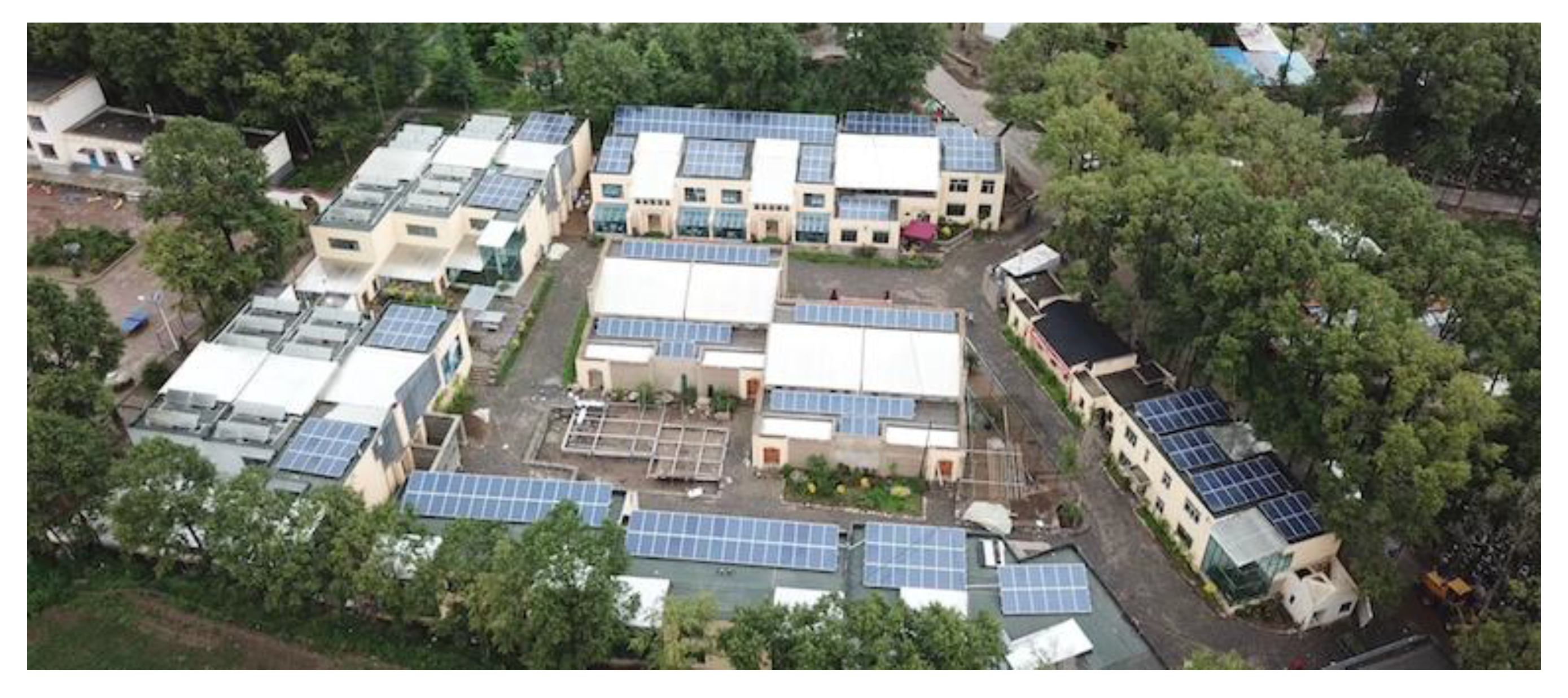

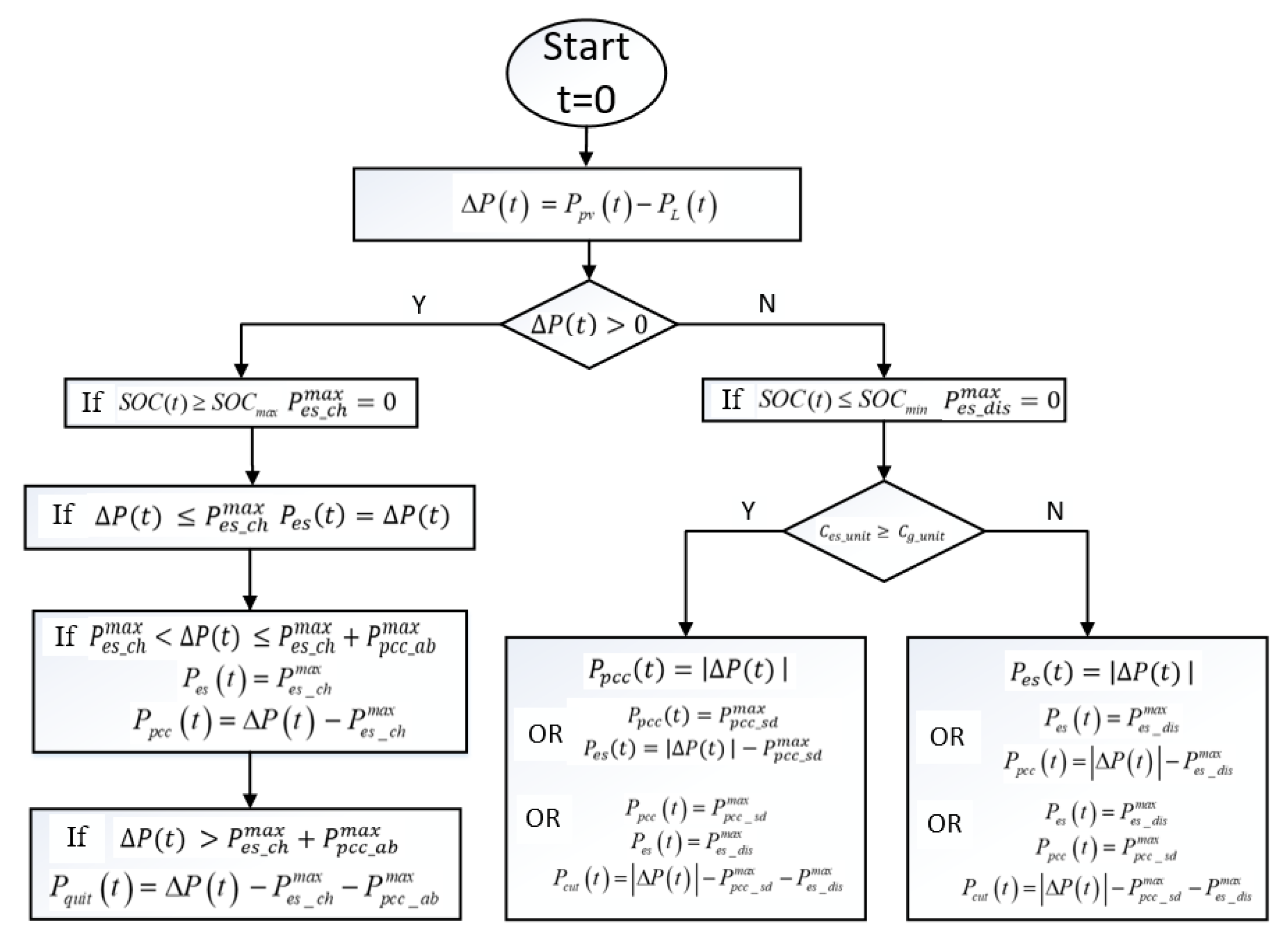
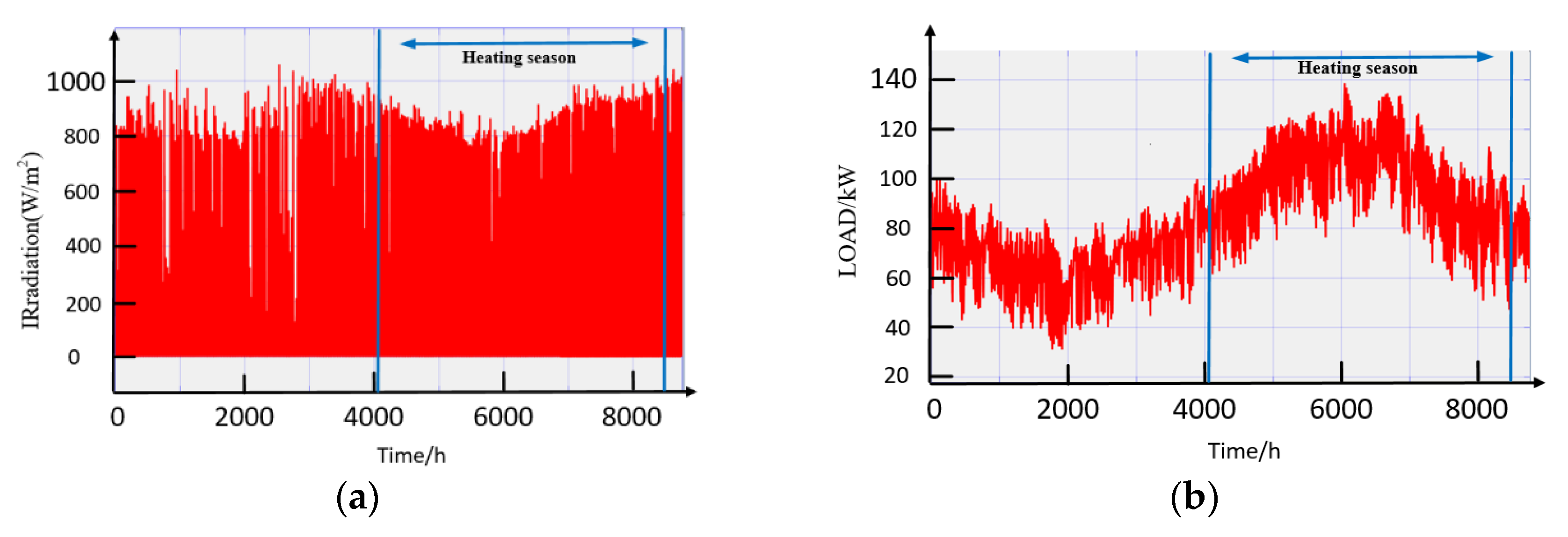

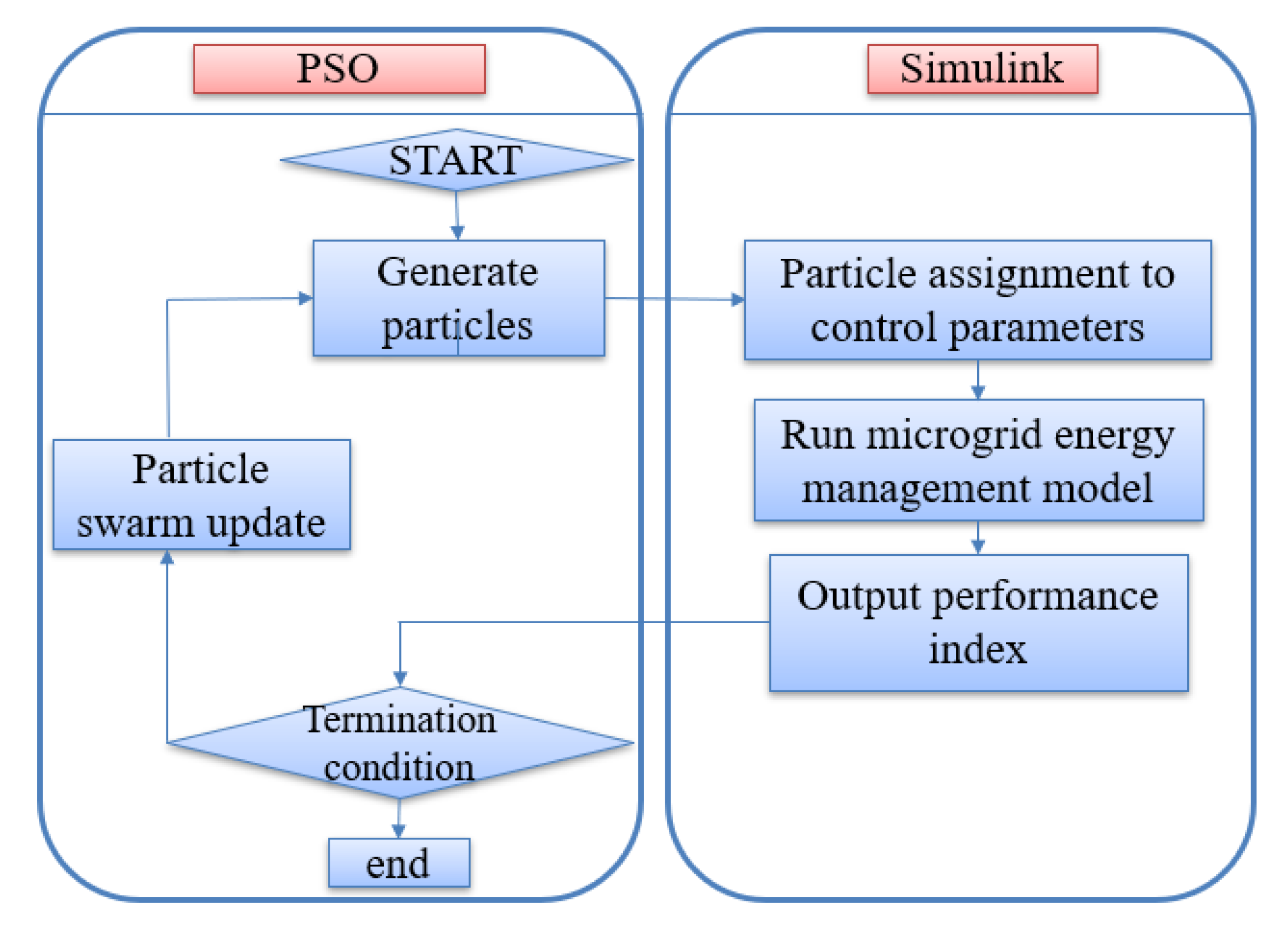
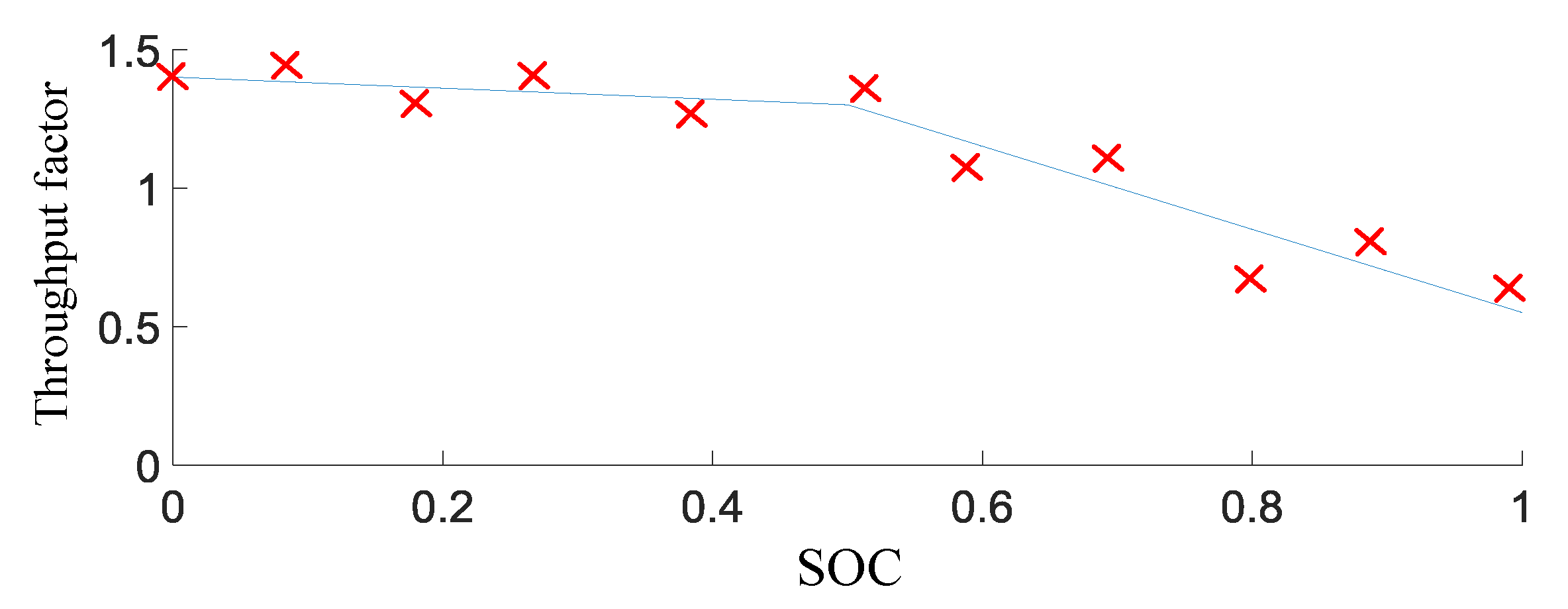

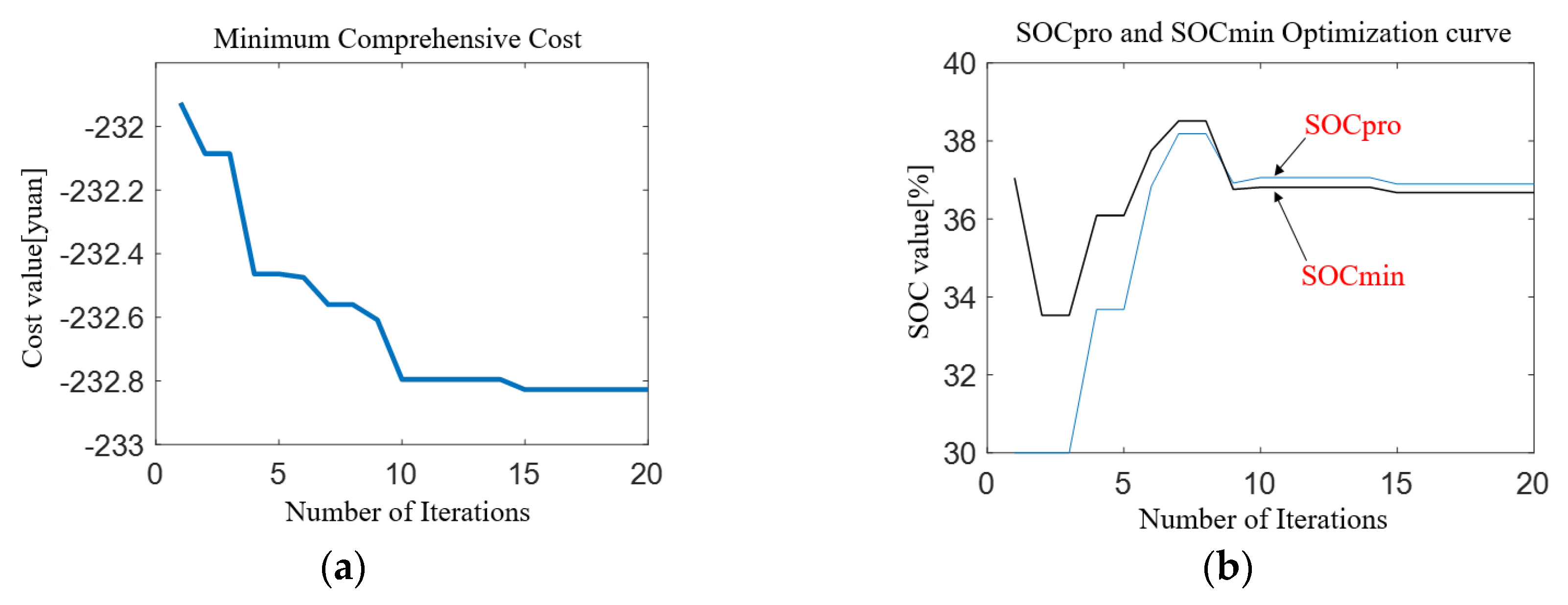
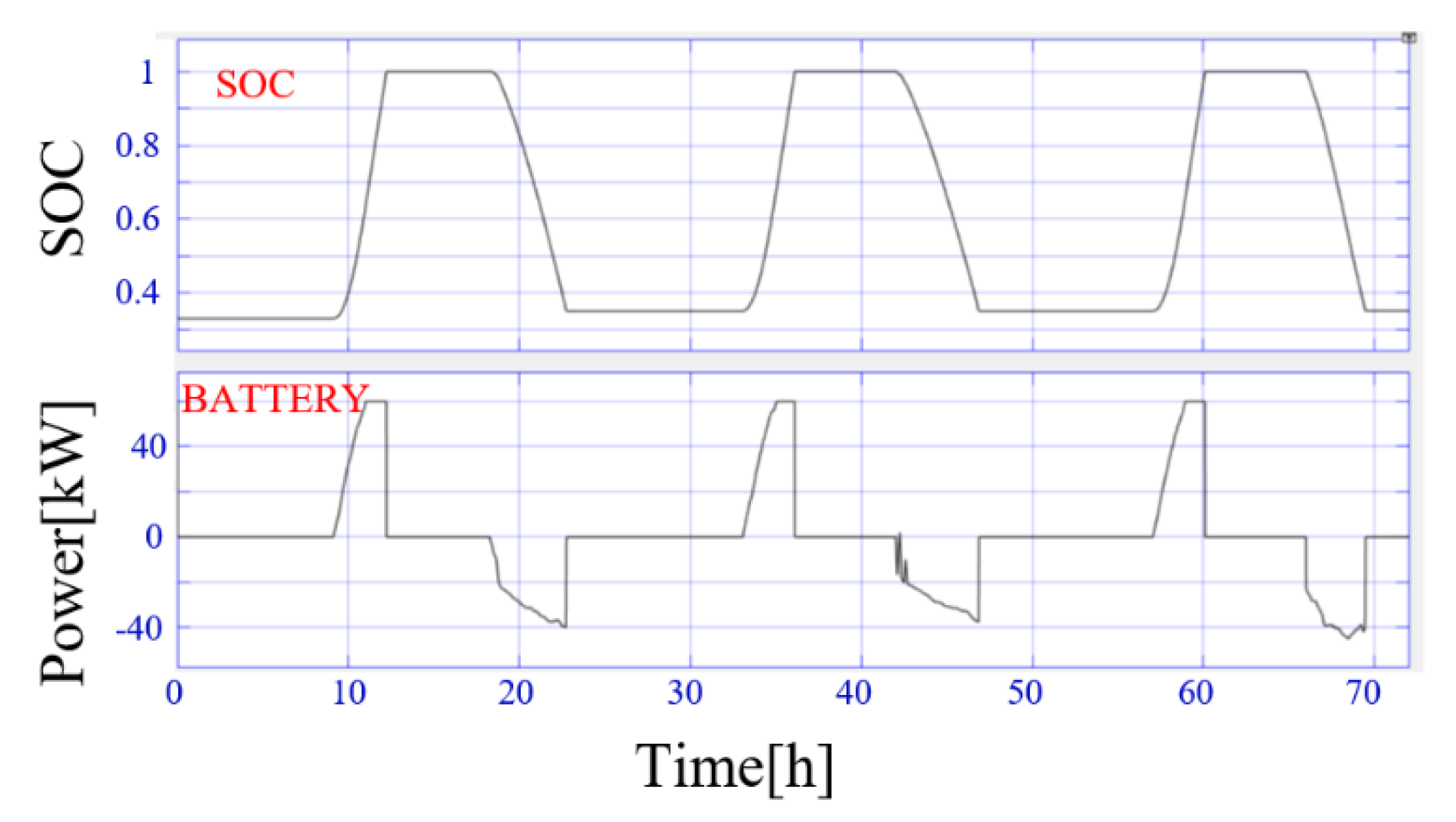

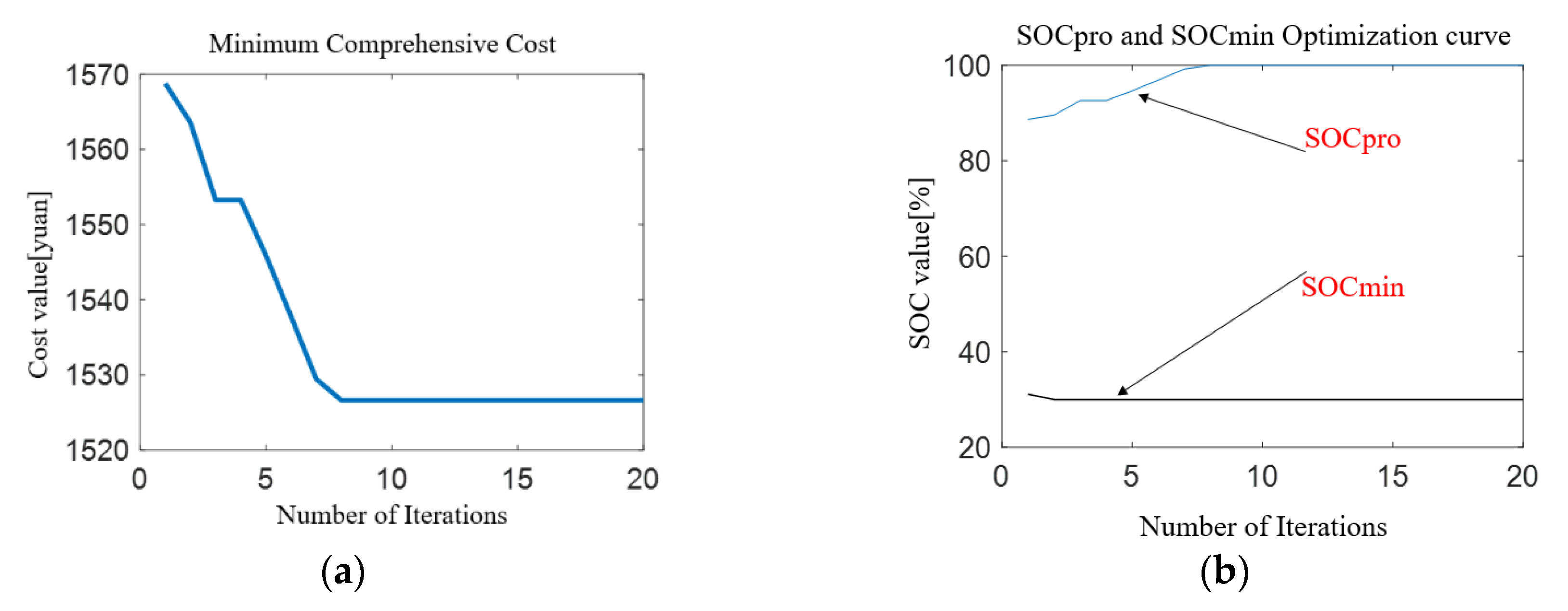


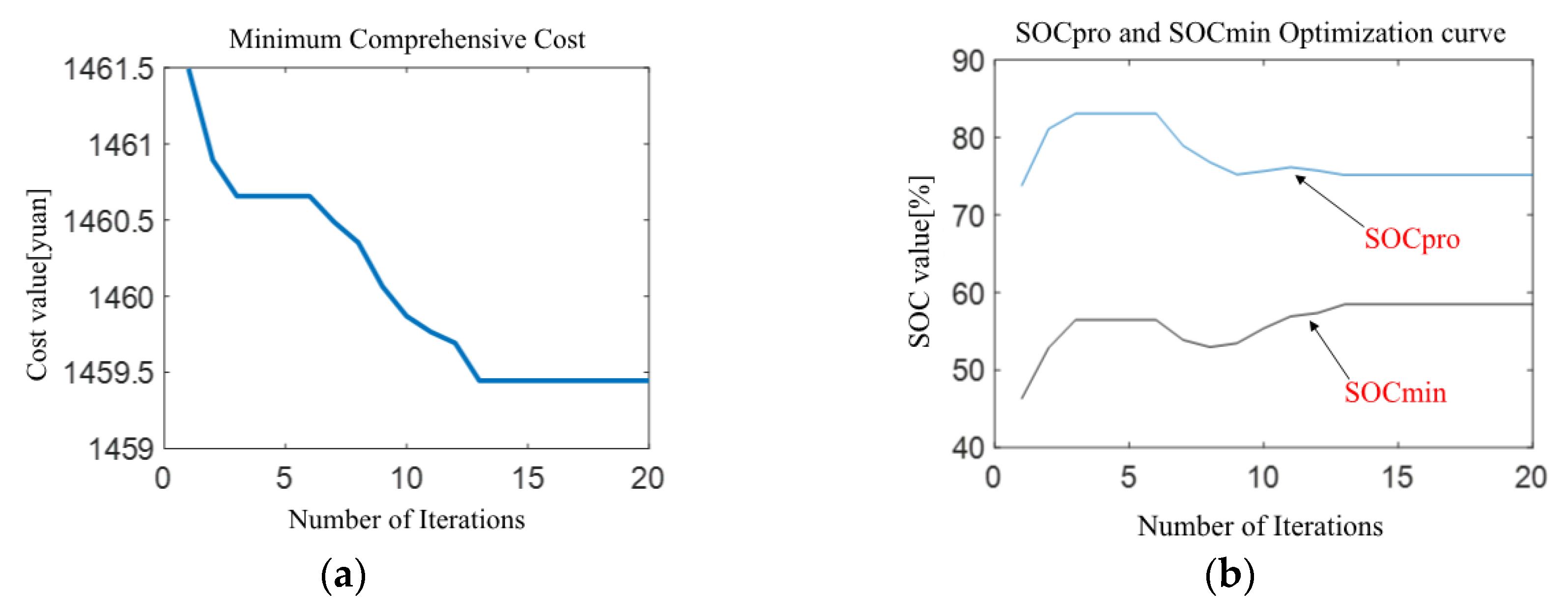
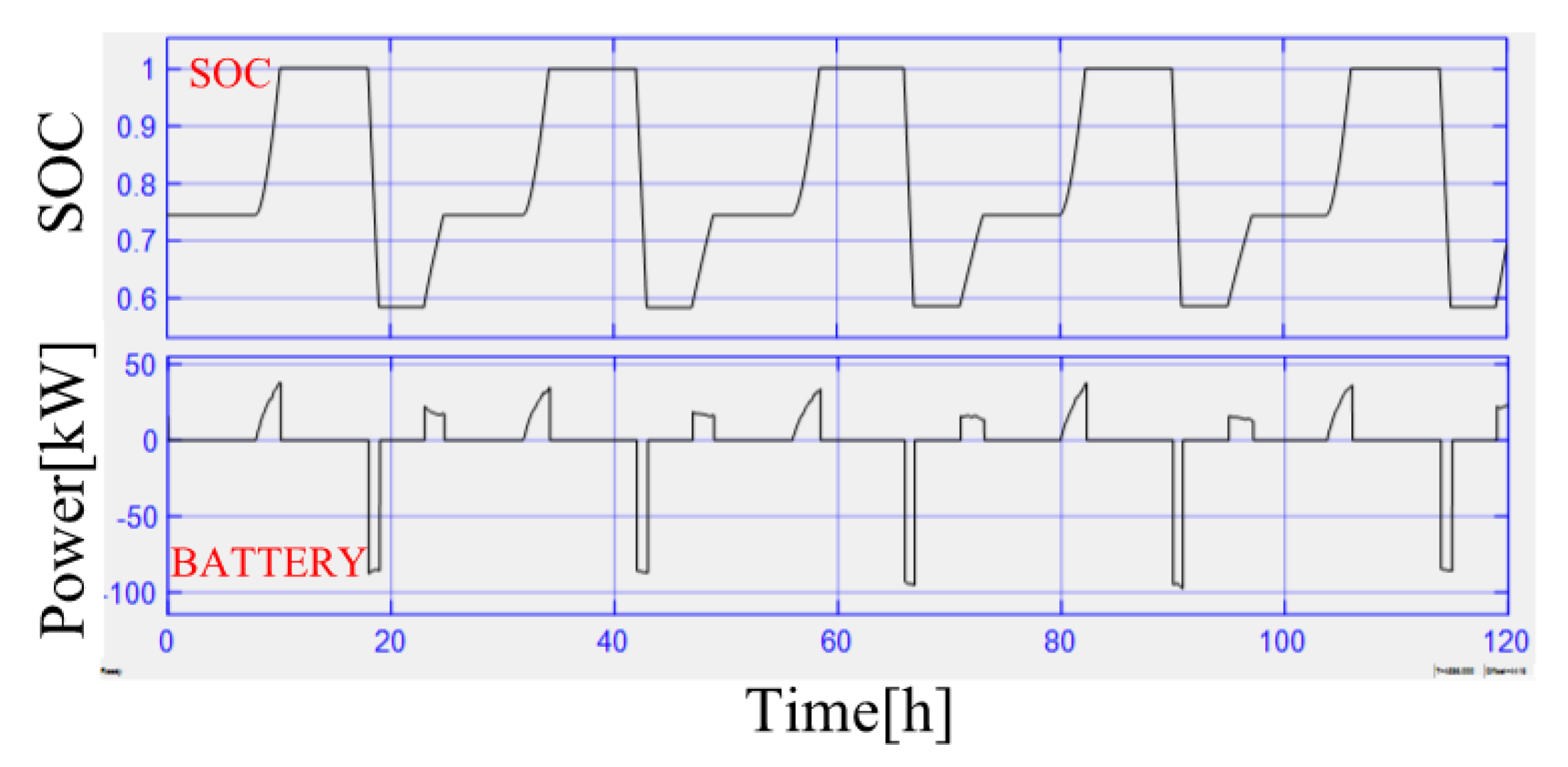

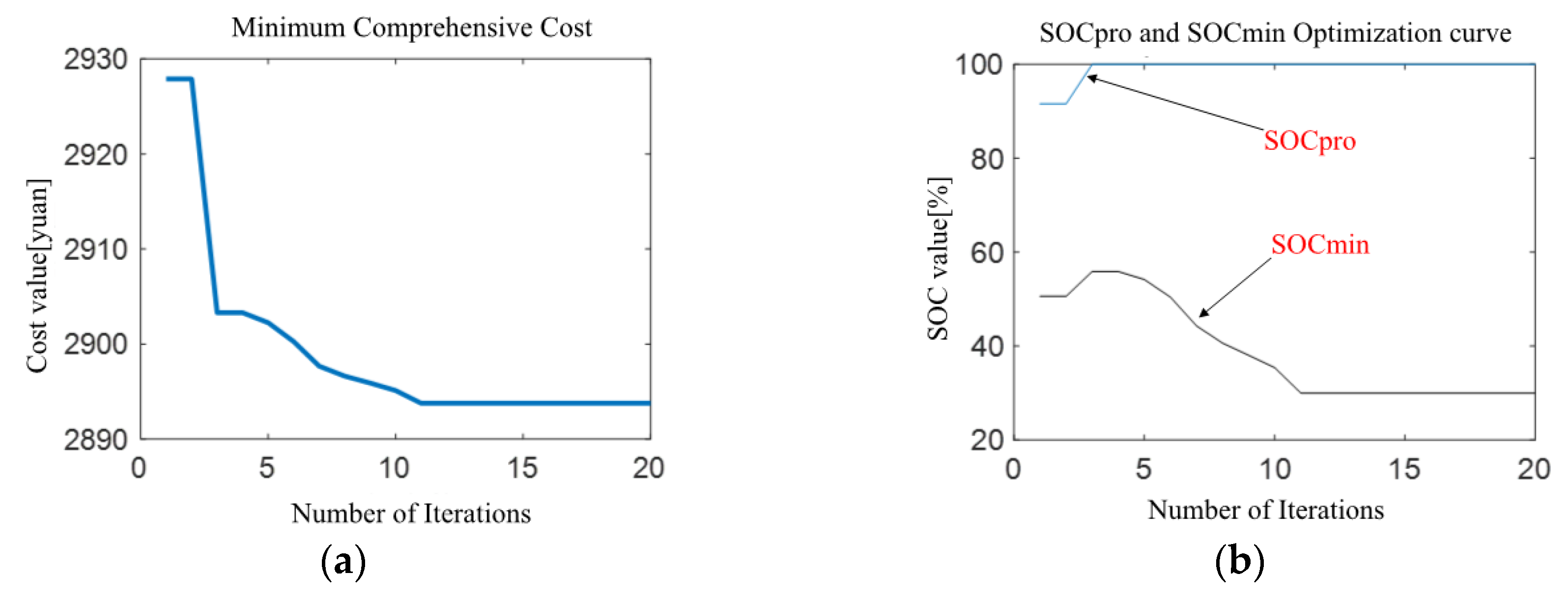



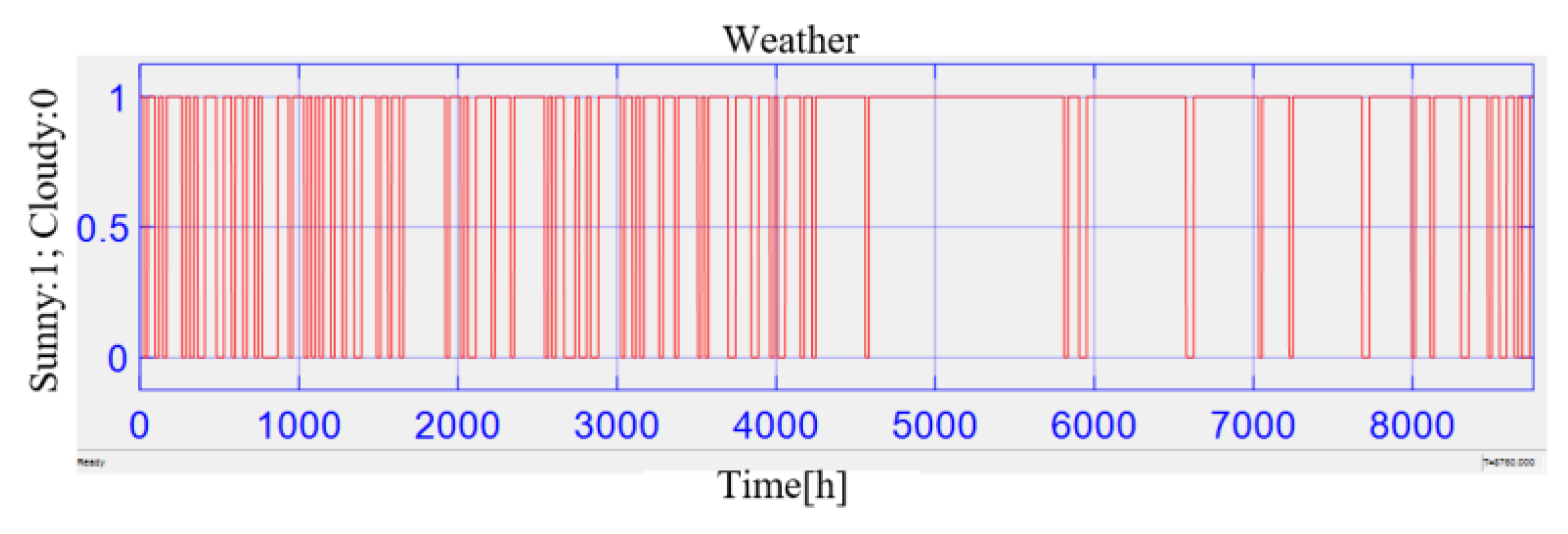

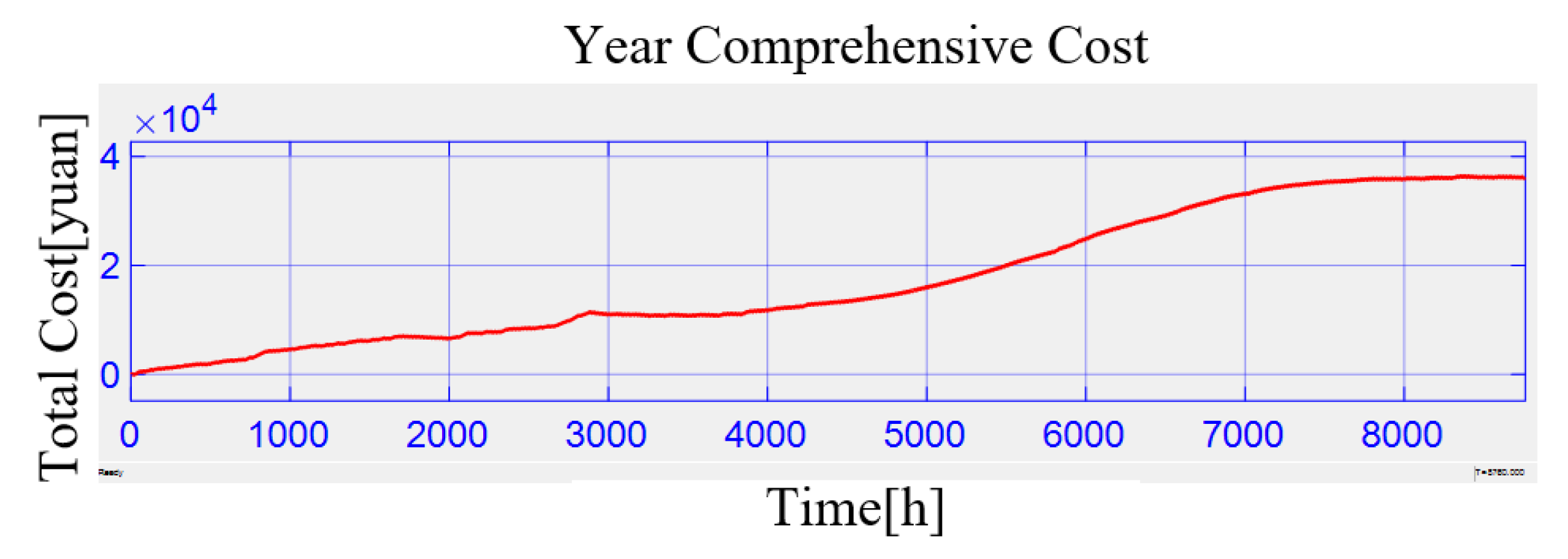

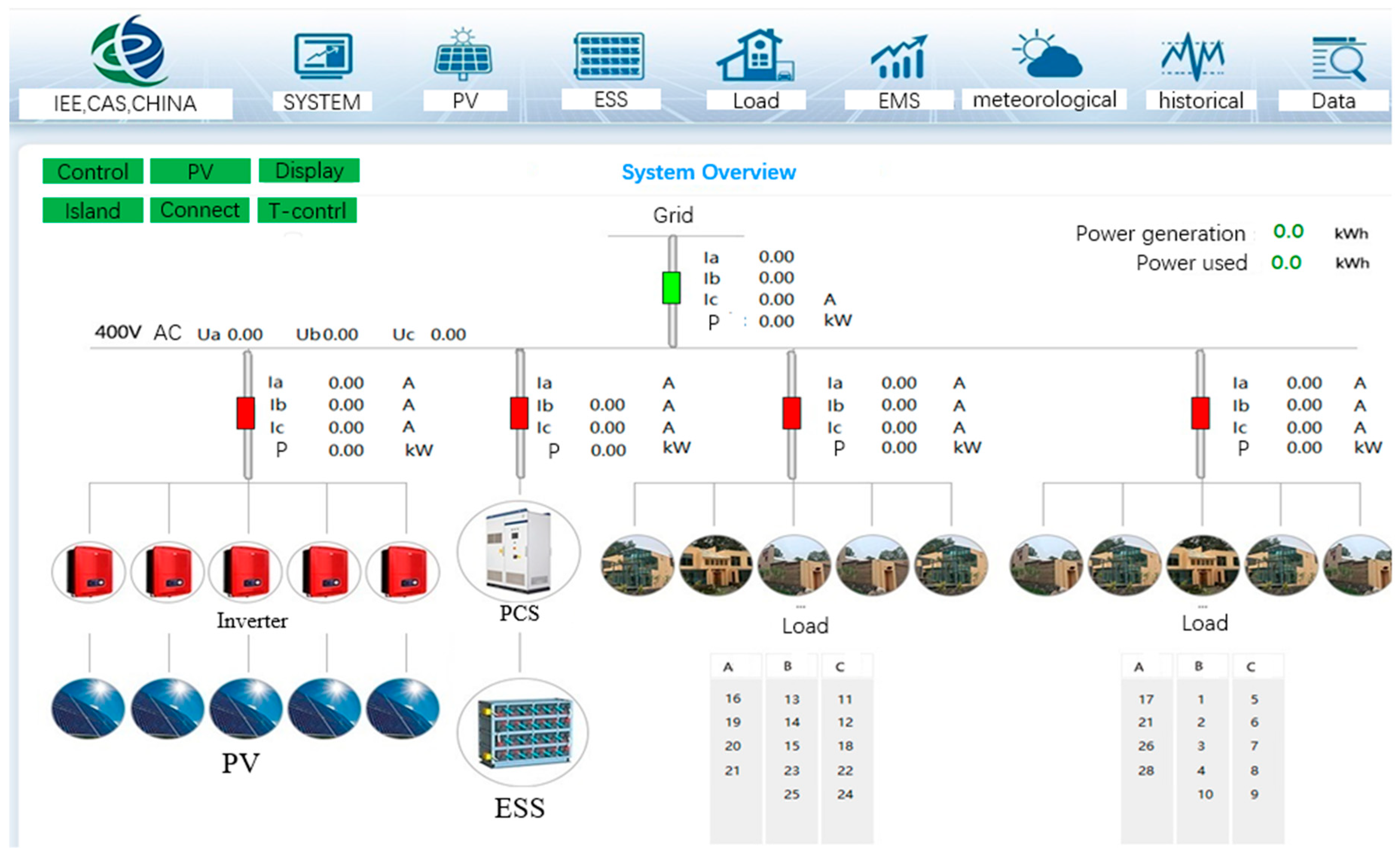

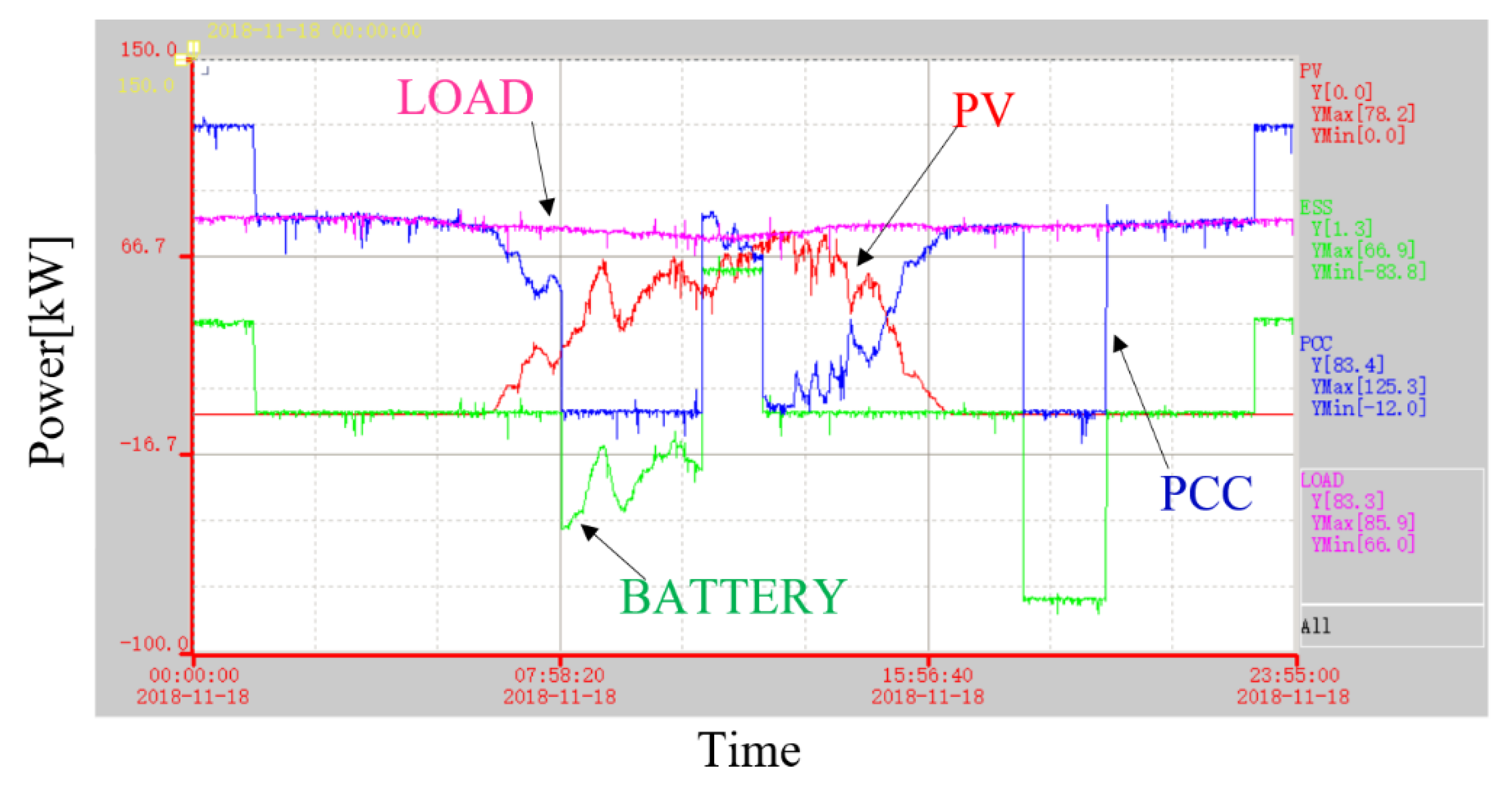

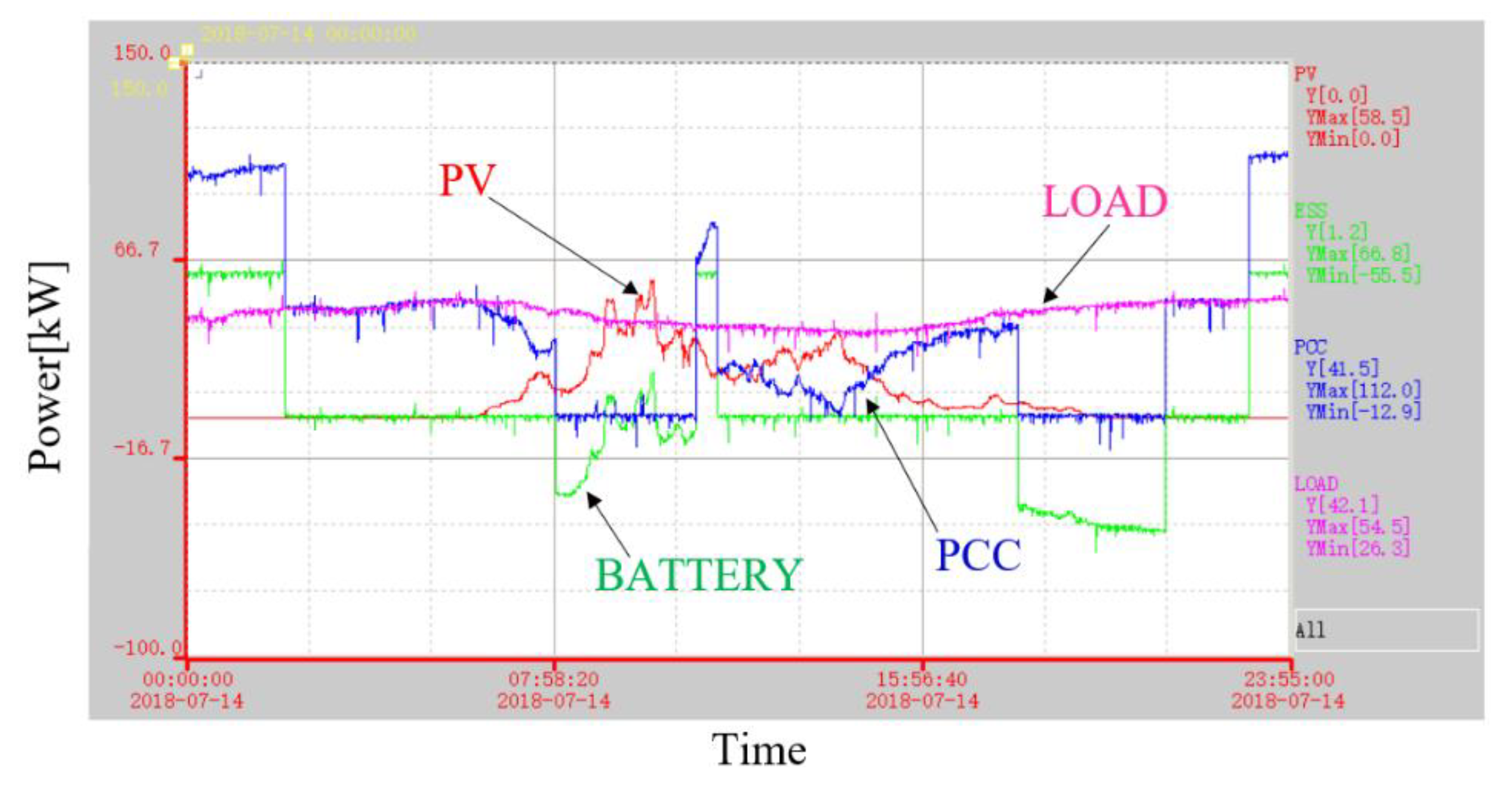
| Parameter | Value |
|---|---|
| Installed capacity of PV generation | 100 kW |
| Battery energy storage capacity | 210 kWh |
| Cost per kWh of the battery | 0.58 yuan |
| Efficiency of ESS | 0.8 |
| Battery maximum charge power | 60 kW |
| Battery maximum discharge power | 100 kW |
| Maximum utility supply power | 120 kW |
| Maximum grid-connected power | 50 kW |
| Peak | Valley | Flat | |
|---|---|---|---|
| Period | (9–12) (18–23) | (0–8) (23–0) | (12–18) (8–9) |
| Price (yuan/kWh) | 0.9402 | 0.6351 | 0.3300 |
| Scenario Number | SOCpro | SOCmin | Comprehensive Cost (yuan/Day) |
|---|---|---|---|
| Scenario 1 | 36.5 | 36.4 | −77.6 |
| Scenario 2 | 100 | 30 | 284 |
| Scenario 3 | 75.15 | 58.47 | 291.9 |
| Scenario 4 | 100 | 30 | 578.8 |
| Strategies | Electricity Cost | Loss Cost of the ESS | Comprehensive Cost (yuan) |
|---|---|---|---|
| Basic real-time control strategy | 22,108 | 18,024 | 40,132 |
| Overall optimization parameters | 21,540 | 16,214 | 37,754 |
| Optimizing parameters by scenarios | 20,538 | 15,649 | 36,187 |
© 2020 by the authors. Licensee MDPI, Basel, Switzerland. This article is an open access article distributed under the terms and conditions of the Creative Commons Attribution (CC BY) license (http://creativecommons.org/licenses/by/4.0/).
Share and Cite
Guo, L.; Yang, Z.; Wang, Y.; Xu, H. Research on Multi-Scenario Variable Parameter Energy Management Strategy of Rural Community Microgrid. Appl. Sci. 2020, 10, 2730. https://doi.org/10.3390/app10082730
Guo L, Yang Z, Wang Y, Xu H. Research on Multi-Scenario Variable Parameter Energy Management Strategy of Rural Community Microgrid. Applied Sciences. 2020; 10(8):2730. https://doi.org/10.3390/app10082730
Chicago/Turabian StyleGuo, Lidong, Zilong Yang, Yibo Wang, and Honghua Xu. 2020. "Research on Multi-Scenario Variable Parameter Energy Management Strategy of Rural Community Microgrid" Applied Sciences 10, no. 8: 2730. https://doi.org/10.3390/app10082730




